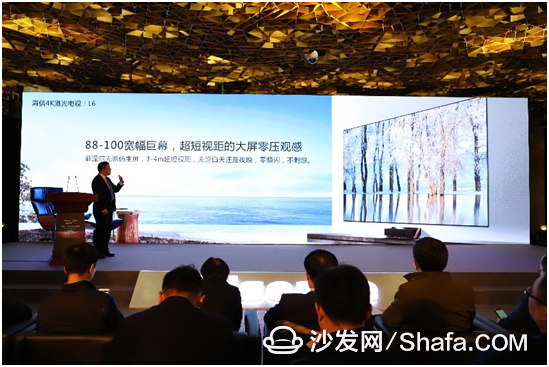In a recent development, Hisense has made significant moves in the television industry by taking down a Toshiba TV deal worth 12.9 billion yen. Meanwhile, the company launched its next-generation 4K laser TV in Beijing, with its new president, Liu Hongxin, personally stepping on stage to present the product. Through this launch, Hisense has clearly shown its ambition to drive TV technology forward and lead the industrial transformation. It also highlights that Hisense is positioning itself at the "commanding heights" of the next-generation TV market.

**Strategic Self-Confidence: Laser TV Is Here to Stay**
As the leader in China's color TV industry, Hisense has taken a bold stance by choosing laser television as its future direction. In Hisense’s view, traditional technologies like LCD or OLED still rely on a visible "screen," which limits innovation. According to Liu Hongxin, the tangible screen has become a barrier for the color TV industry, and disruptive innovations are needed to break through these limitations.
Laser TV, although called a television, brings a revolutionary change in both technology and application. It is considered the "next generation TV." The fusion of projection technology and television makes it the closest to flat display so far. Not only does it overcome screen limitations, but it also has the potential to make displays ubiquitous, offering users an unprecedented visual experience.
Hisense sees laser TV not as a short-term trend, but as a strategic move. The company has over 10 years of R&D experience, more than 400 patents, and 100% self-controlled laser optical engines. This solid foundation gives them confidence in their long-term vision.
Liu Hongxin emphasized that Hisense will continue to support the laser TV line, sending a strong signal of strategic confidence to the market. He also stated that the company has the technical and industrial capabilities to lead the global laser TV market, reinforcing its position as a major player.
**Full 4K, Expanding Scenarios**
Hisense recently launched a series of 4K laser TVs in Beijing, including models from 80-inch to 150-inch, as well as a 120-inch and 150-inch S6 series designed for home theater setups. This launch marks a key milestone in Hisense’s laser TV strategy.
Two aspects stand out:
First, the wide range of sizes—from 80 inches to 150 inches—shows Hisense's ability to mass-produce mainstream products and indicates the maturity of its laser TV technology.
Second, full 4K support is no small feat. While traditional flat-panel TVs haven’t fully adopted 4K, Hisense has already implemented it in its laser TVs, setting a benchmark in the industry.
Gao Yuling, general manager of Hisense Laser Display Co., Ltd., mentioned that Hisense may also enter the sub-80-inch market, which could significantly impact traditional flat-panel TVs.
Looking ahead, the demand for large-screen TVs (70 inches and above) is expected to exceed 4 million units in the next three years. Laser TV, with its ability to break screen limits and offer immersive experiences, is positioned to revolutionize the industry.
According to Zhongkang data, Hisense's 88-inch, 100-inch, and 120-inch laser TVs have captured 43.09% of the 80-inch and above market and 56.27% of the 85-inch and larger segment.
**Improving Standards, Expanding Markets**
Despite its advantages, the laser TV market is still in its early stages and faces challenges. One key issue is the need for improved technical standards. As the market grows, confusion around terms like “laser TV†and “laser projection†has increased, along with varying brightness metrics that confuse consumers.
Another challenge is expanding the industrial alliance. While Hisense leads in the field, it needs broader collaboration. The success of LCDs was due to industry-wide efforts, and similarly, laser TV requires more companies to join and contribute meaningfully.
To address these issues, Hisense has taken proactive steps. It has worked with the China Electronics Standardization Institute to draft the first national standard for laser TVs. Additionally, it is open to welcoming more manufacturers into the ecosystem, offering services such as technology centers and shared resources for 4K optical engines, lenses, and complete systems.
With strategic determination, product innovation, standard improvement, and ecological openness, Hisense is paving the way for a new era in laser TV. The future of television might be closer than we think.
For more smart TV and box information, visit Smart TV/box information network sofa butler (http://), your go-to source for smart TV updates, reviews, and solutions.
Casting Parts
Casting is the process of pouring molten metal into a mold and cooling and solidifying to obtain parts with the desired shape and properties. Casting is a commonly used manufacturing method, with low manufacturing cost and great process flexibility, and can obtain complex shapes and large castings. 50 to 60%.
Due to the increasing requirements for casting quality, casting accuracy, casting cost and casting automation, casting technology is developing in the direction of precision, large-scale, high-quality, automation and cleaning. Casting technology, special casting technology, casting automation and casting simulation technology have developed rapidly.
Casting Parts,Stainless Steel Casting,Investment Casting Meat Mincer,Ductile Iron Sand Casting Parts
Tianhui Machine Co.,Ltd , https://www.thcastings.com